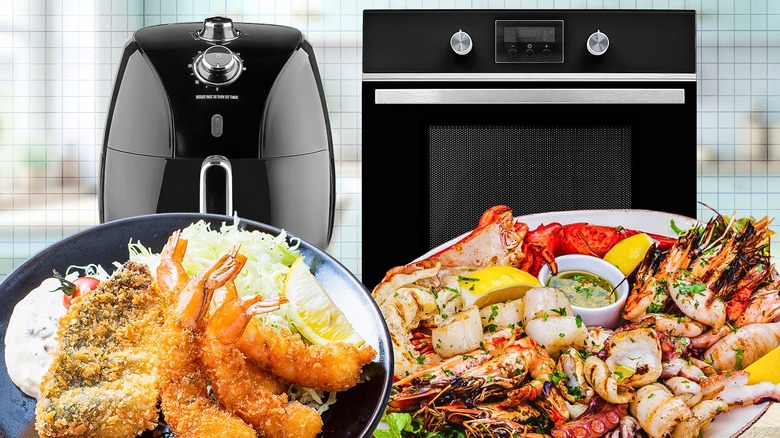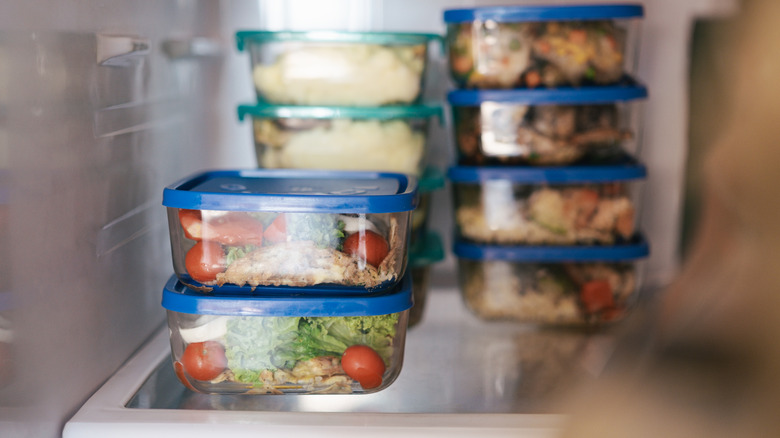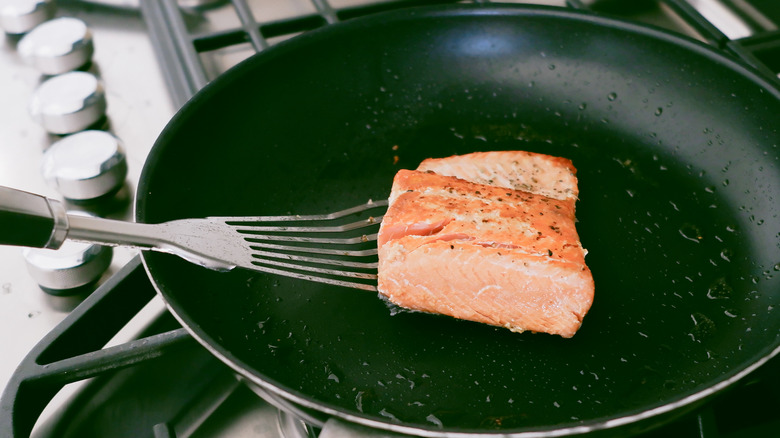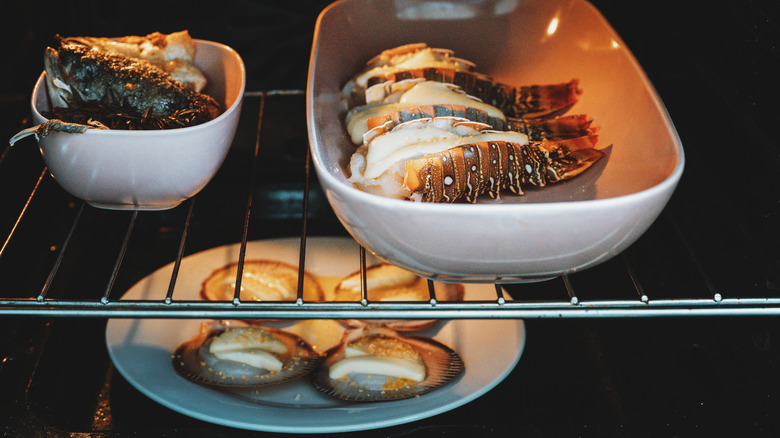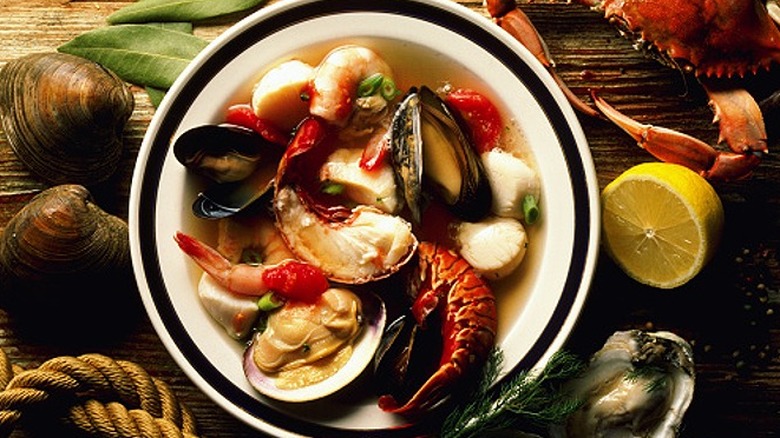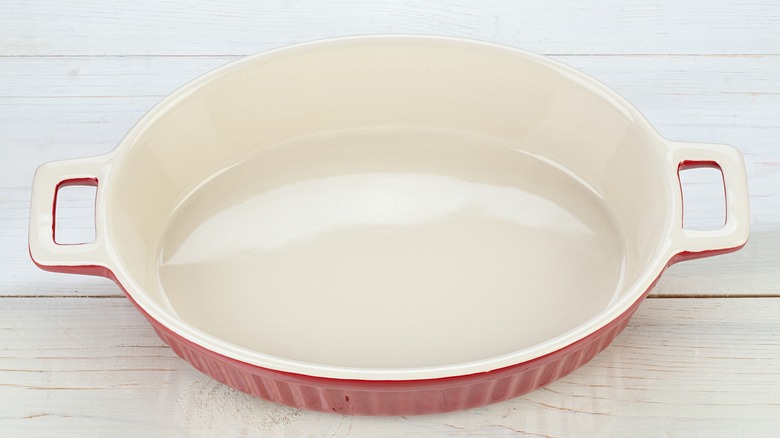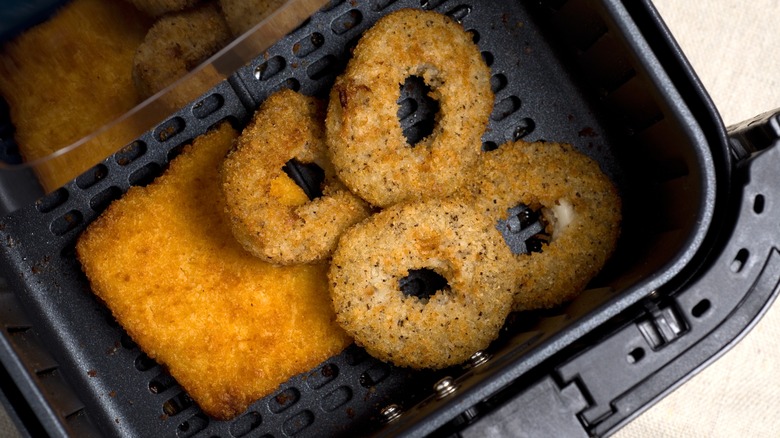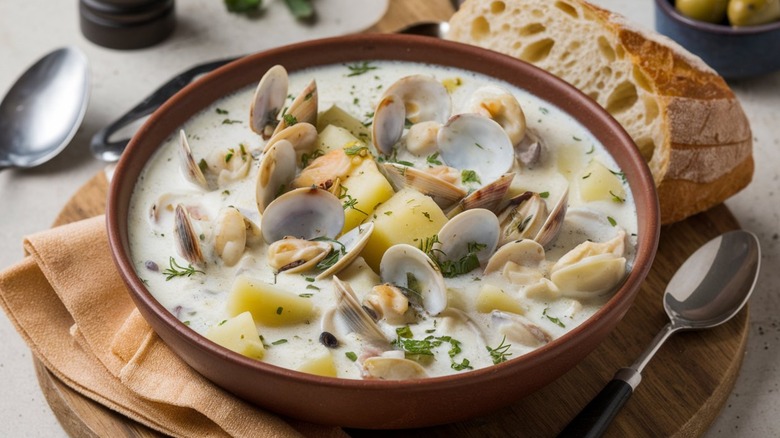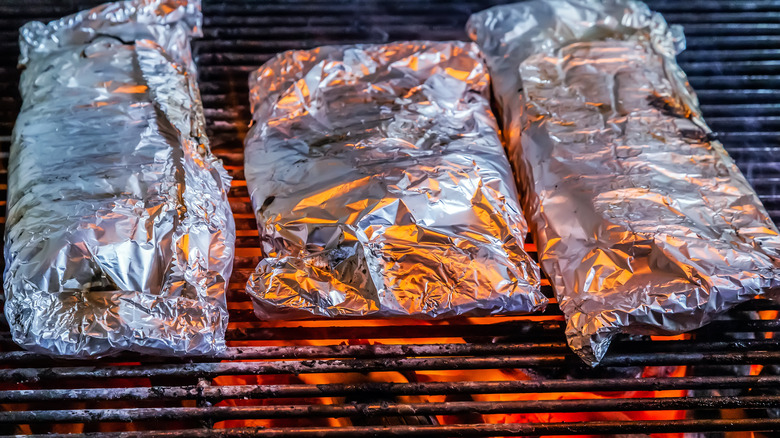8 Tips And Tricks For Reheating Leftover Seafood To Perfection
There's nothing quite like fresh seafood, whether it's delicate cod or salty shellfish. Seafood is so popular that it's frequently the star of events, like shrimp boils, clam chowder cook-offs, and fried fish festivals. But while these are all drool-worthy opportunities to indulge in Poseidon's delights, hardly anyone ever wants to eat seafood as leftovers.
Reheating seafood carries the risk of turning your formerly crispy fried shrimp into bland, soggy, limp sadness. And what was once a sumptuous portion of baked scallops in cream sauce can easily become a separated mess. Leftover seafood might even conjure up memories of someone microwaving fish for lunch in the office and stinking up the entire floor. But it would be a shame to waste that extra bag of shellfish from the neighborhood boil, or toss out uneaten fried fish from the giant platter that you ordered at a local restaurant. Is there any way to save these dishes?
To find out how to reheat seafood so you can enjoy it as much as when it was fresh, we consulted with Joe Isidori, the acclaimed New York City chef and restaurateur. In 2022, Isidori launched Arthur & Sons, an Italian restaurant chain serving seafood ranging from fried calamari to grilled salmon piccata. But first, here's a hint requiring no expert knowledge: Never use the microwave to reheat your seafood.
Store leftover seafood in the coldest part of the fridge
In order to have a chance to successfully reheat your leftover seafood, it should be stored properly in the refrigerator. As soon as you arrive home from a restaurant or a local seafood festival, get your fish into the fridge, pronto. While you can keep perishable food at room temperature for up to two hours (or one hour if the ambient air is 90 degrees Fahrenheit or higher), the quality begins to decline the longer your seafood is not refrigerated.
The location of your fish within the fridge is also important, according to Joe Isidori. "Leftover cooked seafood should be stored in the coldest part of your refrigerator, ideally in the back, where the temperature is more stable," he explains. "This ensures the seafood stays as fresh as possible before reheating."
Make sure your leftovers are properly wrapped or sealed in an airtight container to prevent premature spoiling. Depending on how your leftovers were packaged, such as in a container or a doggie bag, you may need to rewrap them to ensure that the seafood lasts as long as possible. Though the U.S. Department of Agriculture advises that leftovers can safely remain in the fridge at 40 degrees Fahrenheit or below for up to four days, Isidori recommends storing leftover seafood for no more than two days. "After that, the quality begins to decline rapidly, and the seafood can develop off flavors and a less desirable texture," he says.
Be gentle with leftover seafood
Many popular types of seafood are relatively delicate when fresh, and they can be even more delicate to handle after they've already been cooked once. Because of this, Joe Isidori cautions against attempting to reheat fish dishes with high-temperature techniques.
"Be gentle. Always avoid using a very hot oven or high heat, as this can dry out the seafood and compromise its flavor and texture," Isidori says. To treat your leftover seafood with the utmost care, utilize the same tips you need when cooking with fish when it's fresh, which include taking steps to prevent seafood from losing its tenderness. "If not handled carefully, it can lose its moisture and delicate texture," Isidori adds.
Also, make sure to have the proper kitchen utensils for the job. A fish spatula or slotted spoon is designed to gently maneuver seafood so that it doesn't fall apart as you move it around.
Reheat seafood in the oven for best results
For the best results when warming up leftover seafood, Joe Isidori has a favored kitchen appliance. "I prefer using an oven to reheat seafood, because it's gentle," he says. "I recommend setting the oven to 350 degrees Fahrenheit — not too hot, not too low."
Using mid-level heat is effective because it won't overcook your leftovers. "This method works well for both finfish, like codfish, and shellfish, like shrimp," Isidori says. No matter how the seafood was originally cooked, Isidori insists that the oven provides the best method for reheating it. "Whether it's baked or grilled seafood, using a gentle, moist heat will help retain its original texture."
Though the oven can reheat just about any leftover seafood you have, Isidori also mentions that you can also use a grill, if you wrap the seafood in aluminum foil first. Just make sure to include some liquid in the foil pouch and watch it closely so that the bottom of the packet doesn't burn. Sometimes stovetop cooking can be an option for gently reheating leftover seafood, Isidori adds, but oven-baking remains his go-to technique.
Add liquid to prevent your seafood from drying out
"The biggest risk when reheating seafood is drying it out," Joe Isidori warns us. Regardless of whether you're reheating shrimp, salmon, or scallops, losing moisture is the top threat to enjoying your leftover seafood. The first step to keep this from happening is to store it correctly in the fridge. Make sure your food is covered, preferably in an airtight glass container. This helps prevent the cold, arid fridge air from pulling the moisture out of the fish, leaving you with dry, bland, crumbling seafood.
When it comes time to reheat your seafood, Isidori says, "add a little liquid, such as broth or water, to prevent it from drying out." Whether you're looking to warm up a piece of fillet or an entire dish like gumbo, Isidori assures us that you can use the same oven-baking method for reheating, even if your seafood features other ingredients like potatoes or vegetables. However, you still want to keep the oven temperature low to medium. "Just ensure everything stays moist and doesn't overcook, as seafood is particularly sensitive to high heat," he says.
Use the right cookware to reheat seafood
Naturally, if you're reheating food in the oven, you need to use cookware that can safely handle the heat. But there are a number of options to choose from. The ideal cookware for warming up leftover seafood will have deep sides that can safely hold both the seafood and the liquid provided to give it moisture while it's exposed to heat, whether that's a ceramic or glass oven dish, or a metal baking pan.
Choosing the right cookware that can keep the water or broth contained is a more important consideration than worrying about what type of fish you're reheating. "A safe and reliable method is to reheat all types of seafood in an oven-safe dish with a bit of liquid. This helps ensure that the seafood doesn't dry out or burn, particularly with more delicate fish," says Joe Isidori. Using high-sided cookware instead of a baking sheet will also make it easier to remove the reheated leftover seafood from the oven without spilling any hot liquid that may remain with your food.
Consider using an air fryer to reheat fried seafood
We already know that you can turn to your air fryer for the absolute best shrimp, but it turns out that any type of leftover fried fish can also be reheated in this appliance in order to help restore its crunchy exterior while preserving the integrity of the fish itself. "Fried seafood can be trickier, but reheating it in the oven or an air fryer can help maintain its crispness," says Joe Isidori. He's had success with fried seafood using the air fryer, telling us that "it creates a perfect environment with its combination of dry and moist cooking techniques, which works well for reheating without losing too much texture."
If you don't have an air fryer to warm up your leftover fried calamari, you can still use the oven. The rule of applying moisture still stands, as does the suggestion to utilize low-to-mid-range temperature levels, but instead of adding liquid to your baking dish, lightly spray your fried fish with cooking oil. This helps keep the batter or exterior of the fish moist, while adding fat to maintain its crunch as it heats up in the oven. Plus, the oil helps lock in the seafood's interior moisture, so the meat doesn't become dry.
Transform leftover seafood into a fresh dish
With leftover seafood, you have the option of reheating it as it was originally prepared and served — or you can transform it into another seafood meal that's essentially made from scratch. "If the seafood was cooked simply, it can easily be incorporated into another dish," advises Joe Isidori.
If you have leftovers from a seafood boil, or a grilled or broiled restaurant meal, your seafood hasn't been manipulated much beyond its original form. This makes it easier to add the fish to fresh ingredients without compromising your new recipe. It also opens up a range of possibilities for you to enjoy your seafood the second time around.
"For example," Isidori tells us, "you could elevate a traditional New England clam chowder by adding cooked seafood like shrimp, scallops, or lobster." Once you've created your fresh clam chowder recipe or even a new slow cooked seafood boil, add in the leftover fish to gently warm it up with your fresher ingredients. You could also sauté cooked seafood to warm it through, and then toss it with pasta or rice and vegetables for a quick lunch or dinner. "This can transform leftover seafood into a fresh, exciting dish," says Isidori.
Keep a close eye on leftover seafood
Keep an eye on your leftovers, even while storing them in the fridge. Know what to look out for to avoid eating spoiled food. If your leftover seafood smells off, looks iffy, or has grown mold, toss it.
Your powers of observation are crucial when preparing to eat your leftover seafood, as well. Joe Isidori stresses the importance of watching your leftovers closely when reheating them. Remember that seafood is delicate and sensitive to heat, and this is especially the case when it's already been cooked. Adding more heat to cooked seafood increases the risk of overcooking it to the degree of drying out, or even making it burnt and inedible.
Be careful about the temperature you use, whether you're reheating seafood in the oven or using another appliance. Keep the heat low to medium so that you don't scorch the food. Likewise, keep an eye on the amount of time your leftover seafood is being heated. Reheating should take only a matter of minutes. You want to carefully warm up the leftovers; you're not actually cooking them. This is not the type of food you put in your oven and walk away from.
